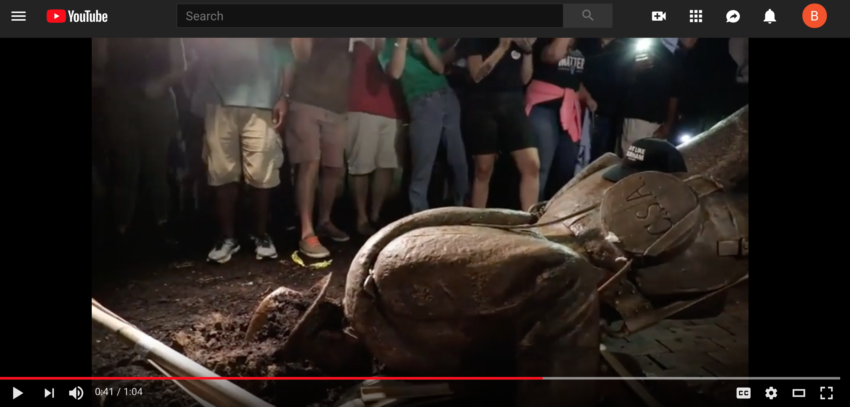From the BBC, in Bristol:
Further empirical research needs to be done to determine if all such statues are so poorly attached to their pedestals.
8/21/2018: Video captures UNC students in sensible act of vandalism
InsideHigherEd report here.
… The move came after years of debate. As many other colleges and universities removed Confederate statues and symbols, UNC officials said that they lacked the power to remove the statue, with the campus deferring to the system, and the system board last month saying that any decision needed to come from a state agency, and that the system had no plans to ask that agency to act. …
Video here:

This post is not in any way meant to encourage UO students to drag the Pioneer Mother and Father statues over to the graveyard, nor am I being paid to endorse this Harbor Freight winch with a series-wound motor to endure long pulls, and discrete remote control:

No, for maximum safety we need a committee.
Oh good, we need room for the new Trump 2020 statue!
What’s sauce for the goose is sauce for the gander.
Also, punching people we don’t like, mutatis mutandis.
Honest question, what’s wrong with the pioneer father and mother?
The argument is that they celebrate a group that displaced and killed and oppressed the original inhabitants of the area. The argument is that the statues celebrate, generically, folks who committed genocide in building the state. Also, their creator was I guess a major creator of Confederate monuments.
That said, I think what happened in UNC is the wrong way to go about this. I hope UO Matters is joking in calling for their removal through these means.
If we kept them in place, we could ceremonially stone them every year. Wouldn’t that be better than removing that genocide from everyday memory?
(Also, it would give the History 101 class a chance to remind freshkids that essentially every society has killed and oppressed the original inhabitants of their domains.)
Nice try Dog, but my attorney has advised me that under the 5th amendment I don’t have to answer this question.
Five years ago I would have laughed at the idea of removing the Pioneer Mother and Father statues. This was despite the fact that, as a Connecticut Yankee kid growing up in Charlottesville VA, I hated the Confederate statues, and I knew exactly why they’d been put up in the Courthouse square – to make sure Black people knew that Lincoln was dead and that the descendants of the slavers were back in charge of the South.
The Pioneer Mother and Father, on the other hand, I took as symbols of the new America and freedom. And they certainly don’t have the triumphant man on horseback aspect of Lee and Jackson. (For the record, both were losers. Thank you U.S. Grant.) In contrast, our Pioneer Father looks like his life’s ambition is a squirrel for dinner. Mother looks like she just got off a flight from Missouri with a 4 hour delay in SF and just hopes the grandkids are already in bed so she can talk to her daughter. Pretty good stuff, for public art.
But, as Senate Pres you have to listen to a lot of people, and sometimes you learn things. Sometimes those things aren’t what you want to learn.
In my case, I didn’t want to learn that the Pioneer statues were a simplistic, romanticized representation of western expansion that made most of us feel good and helped us avoid thinking about the stolen land, genocide, racism, and massacres. But they are.
I hope it’s clear that I love these statues. I just think that they belong in the graveyard. And I’d like to believe that the anonymous pioneers they represent would be happy to rest there. They were no dummies. They knew what they’d won, and what others had lost, and that the wheel would come around again.
The alternative to a midnight removal to the conveniently located Pioneer Cemetery is a long drawn out process to create some new public art to place next to Ma and Pa that somehow, will represent the complicated history that actually transpired over the last 170 years. All approved by a committee.
That art is going to cost a lot more than a $269.99 winch, and it’s going to be really ugly. If you don’t believe me, just take a look at what’s in front of Straub now.
For what it’s worth, I have no particular problem with moving them to the Cemetery, if the caretakers feel it’s appropriate. I was under the impression that you were suggesting that they be destroyed, as apparently happened (or was intended) in the UNC case. That sort of thing smacks more of ISIL, IMO…
https://en.wikipedia.org/wiki/Destruction_of_cultural_heritage_by_ISIL
Sorry–I blow all of my money on alimony.
Coincidentally, the alimony problem is also solvable with a BadAss wench ..
The genocide story is a little more complex in the Pacific Northwest because by the time American settlers arrived, the Native population had already been decimated by disease introduced by the Spanish which spread up the West Coast. (See e.g.
here. So the Pioneer Mom & Dad didn’t actually go out and kill Native people, they displaced them after somebody else did most of the job. But put me down for the winch anyway.
This narrative so massively distorts the historical record I don’t even know where to begin. Let’s just say this: You are incredibly ignorant if you think the undeniably enormous impact of earlier European and American incursions on the native nations in the West means that “Pioneer Mom & Dad didn’t actually go out and kill Native people”.
Please provide some information to go along with your insult.
Oh come now, there is more information there than in many posts and it challenges a quote that is cited directly. That seems fair.
Also, UO Ph.D. David Lewis and literally dozens of readily accessible histories of the first 50 years of settler colonialism in Oregon and the PNW: (https://ndnhistoryresearch.com/2016/08/12/american-complicity-in-genocide-in-oregon/)
To take one of countless examples, Lewis cites a story in The Oregonian from 1851 that includes this statement about our own contemptible Joseph Lane: “During the night of the 24th, Gen. Lane, with a small party of citizens also joined us, and we had now quite a formidable party. From the time we have been searching about in the mountains, destroying villages, killing all the males we could find, and capturing women and children. -R.S.W.”
So it seems our Pioneer Father’s rifle was for humans, not just squirrels. The truth hurts, but it’s a good hurt. Thanks.
The circa 1850 battle of Abiqua
https://ndnhistoryresearch.com/2017/12/30/the-battle-of-abiqua-second-battle-of-the-willamette-valley/
I will fight no more forever, chief josephs words, but they could just as easily been uttered by Tecumseh, sitting Bull, Crazy horse, Red Cloud, Geronimo, Cochise, or Quanah Parker. iMHO, the problem with reductive symbols and even words is that they gloss over the texture of much more complex and powerful truths. IMHO, time to give our Pioneer Mother and Father either a less prominent resting place or a place that provides at least some of the texture of the larger truth, the latter may be too difficult. at the same time, the history is too complex to be reduced to single words. iMHO
a heads up on a EW piece on this summer’s Bach festival:
https://www.eugeneweekly.com/2018/08/23/a-year-after-the-firing/
A bit of aftermath. There are some calls for the statue to be restored:
http://thehill.com/blogs/blog-briefing-room/news/403573-unc-board-member-calls-for-confederate-statue-to-be-reinstalled
Here’s the WP page:
https://en.wikipedia.org/wiki/Silent_Sam
On the “against” side, the destruction is being generally viewed as civil disobedience. This seemed odd to me, as the civil disobedience of Gandhi or MLK could not have been mistaken for vandalism, nor mob activity.
At least per Wikipedia, that idea of civil disobedience is not necessarily the broadly accepted definition. (The broad definition seems to merely involve refusing to obey a law because “reasons”.)
Contrast this quote from MLK: “Any man who breaks a law that conscience tells him is unjust and willingly accepts the penalty by staying in jail in order to arouse the conscience of the community on the injustice of the law is at that moment expressing the very highest respect for law.” This is a deeply noble idea, and the willingness to accept the penalty makes all the difference.
“Willingness to accept the penalty” does sound deeply noble. But it’s generally not the most effective strategy.
For example, Nelson Mandela did all he could to avoid paying the penalty for his noble work, and so was able to continue it far longer than otherwise. Sam Adams and the other perpetrators of the Boston Tea Party went to great lengths to avoid being caught and they are also widely admired, in part because they got away clean and so were able to keep organizing.
King generally did not stay in jail, for pragmatic reasons. He was much more useful outside than inside as all his followers recognized. One occasion where he did stay in jail was when he wrote the famous letter from a Birmingham jail, but the point of the whole exercise was to speak to the consciences of people, which going to jail sometimes does but sometimes does not.
Mandela and Adams were effective fighters for their cause, no doubt.
Gandhi and King were transcendent, and are remembered in a different way for a reason. I still choke up some times thinking about them. Just getting old I guess…
BTW, thanks for linking the InsideHigherEd article. One of the comments references The Declaration Of Causes of Seceding States. I suggest everyone read it, especially the one issued by Mississippi. It was all about slavery, and the belief that the white race was put in place to conquer America, and African slavery was vital to that cause.
But several Confederate states also point out economic and financial reasons why they left the Union. Very interesting historical artifact..,